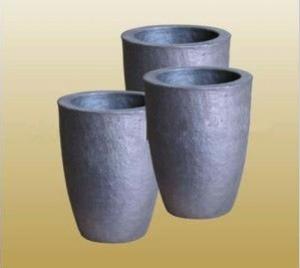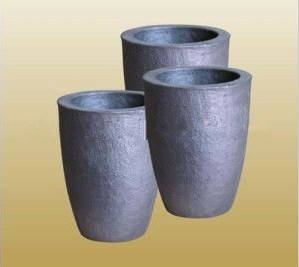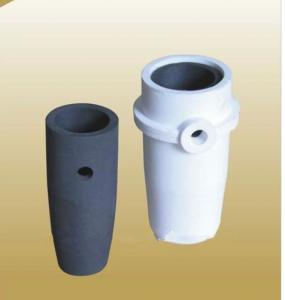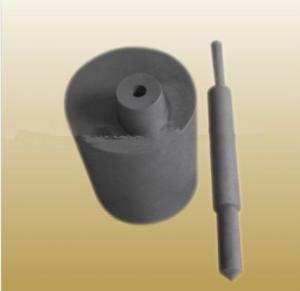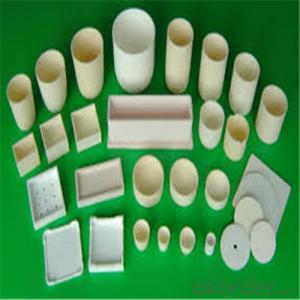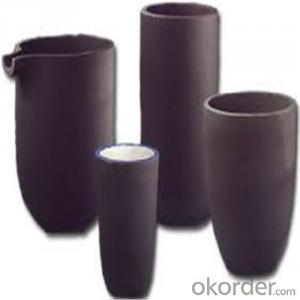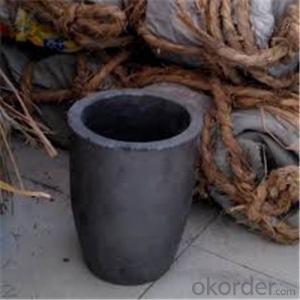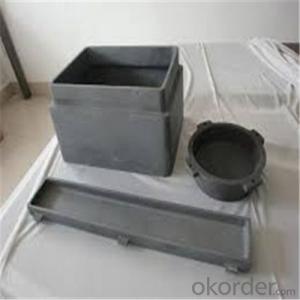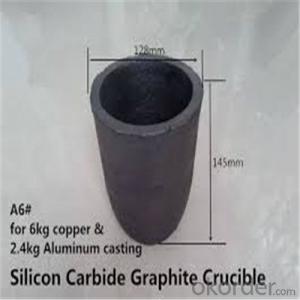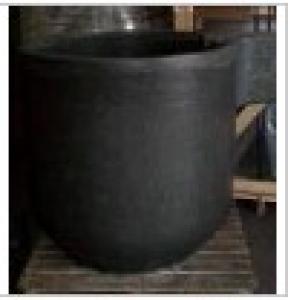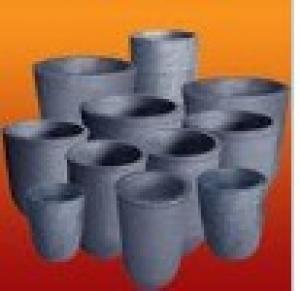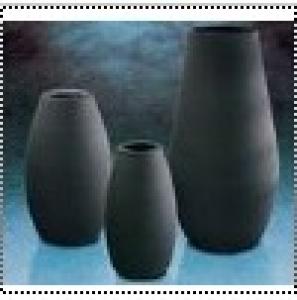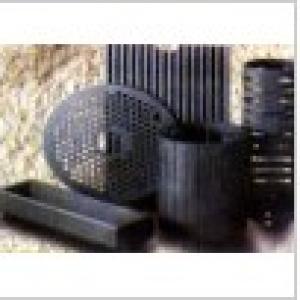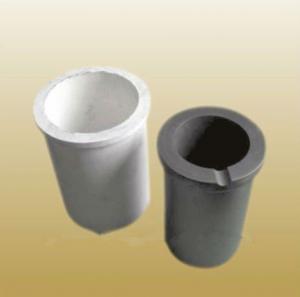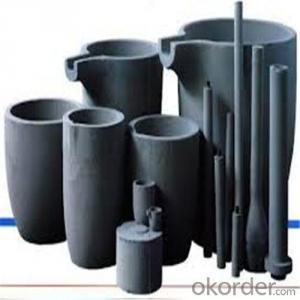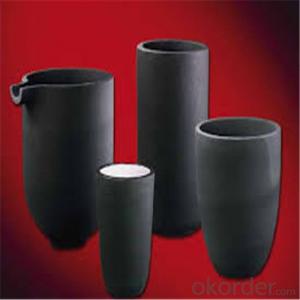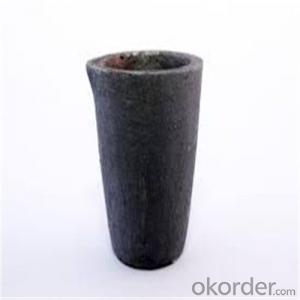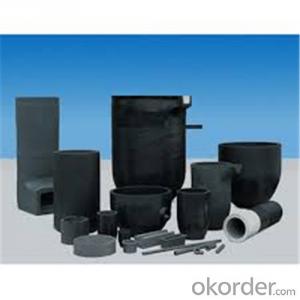Silicon Carbide Graphite Crucible Amazon
- Loading Port:
- China Main Port
- Payment Terms:
- TT or LC
- Min Order Qty:
- 5 Pieces pc
- Supply Capability:
- 10000 Pieces per Month pc/month
OKorder Service Pledge
Quality Product, Order Online Tracking, Timely Delivery
OKorder Financial Service
Credit Rating, Credit Services, Credit Purchasing
You Might Also Like
Detailed Product Description
1. Top quality crucibles offer consistent performance when melting ferrous, onferrous and precious metals.
2. Good thermal conductivity keeps metal from cooling too rapidly. Made of natural flake graphite and silicon carbide bonded with find clay, lined with mullite for long life.
Specification:
| NO | Modle Number | Up Dia(mm) | Down Dia(mm) | High(mm) |
| 1 | 80# | 300 | 175 | 358 |
| 2 | 100# | 326 | 200 | 366 |
| 3 | 120# | 345 | 195 | 383 |
| 4 | 150# | 370 | 192 | 430 |
| 5 | 200# | 398 | 220 | 490 |
| 6 | 250# | 450 | 240 | 550 |
| 7 | 300# | 470 | 240 | 573 |
| 8 | 350# | 485 | 275 | 610 |
| 9 | 400# | 520 | 282 | 648 |
| 10 | 500# | 540 | 313 | 698 |
| 11 | 800# | 630 | 335 | 720 |
| 12 | 1000# | 640 | 380 | 773 |
- Q: How does the density of graphite crucibles affect their performance?
- The performance of graphite crucibles is significantly influenced by their density. These crucibles find wide application in high-temperature scenarios such as metal and alloy melting. The density of the crucible impacts its strength, thermal conductivity, and resistance to thermal shock. Generally, a higher density graphite crucible is preferred due to its superior mechanical strength and durability. This is especially important in applications involving frequent heating and cooling cycles, as a lower density crucible may be susceptible to cracking or damage. A higher density crucible can endure higher temperatures and offers better resistance against the corrosive effects of various molten materials. Additionally, density plays a role in the thermal conductivity of the crucible. A higher density graphite crucible tends to have higher thermal conductivity, enabling more efficient heat transfer between the crucible and the material being melted. Consequently, this leads to faster melting times and enhanced overall performance. Moreover, the density of the crucible affects its resistance to thermal shock. Thermal shock occurs when there is a sudden temperature change, resulting in internal stress within the material. A higher density crucible generally exhibits greater resistance to thermal shock, thereby reducing the likelihood of cracking or failure during the melting process. To summarize, the performance of graphite crucibles is directly influenced by their density in terms of mechanical strength, thermal conductivity, and resistance to thermal shock. It is crucial to select a crucible with the appropriate density for a specific application to ensure optimal performance and longevity.
- Q: Are there any special precautions to be taken while using graphite crucibles?
- Yes, there are several special precautions that should be taken while using graphite crucibles. First, it is important to handle graphite crucibles with care as they are fragile and can break easily. Avoid dropping or mishandling them to prevent cracks or damage. Secondly, graphite crucibles should be stored in a clean and dry environment to prevent any contamination. Graphite is susceptible to absorbing impurities from the surroundings, which can affect its performance and durability. During use, it is crucial to avoid exposing graphite crucibles to rapid temperature changes. Sudden heating or cooling can cause thermal shock, leading to cracks or even breakage. To prevent this, it is recommended to gradually heat or cool the crucible within the recommended temperature range. Additionally, graphite crucibles should be properly seasoned or preheated before using them for the first time. This involves slowly heating the crucible to a specific temperature to remove any moisture or volatile substances that might be present. Failure to properly season the crucible can lead to cracking or premature failure during subsequent use. Furthermore, it is important to avoid overloading the crucible with excessive material. Graphite crucibles have specific capacity limits, and exceeding these limits can cause the crucible to fail or reduce its lifespan. Lastly, when handling molten materials or pouring them into the crucible, appropriate personal protective equipment should be worn. This includes heat-resistant gloves, face shields, and other protective clothing to prevent burns or injuries. By following these precautions, users can maximize the lifespan and performance of graphite crucibles while ensuring safe and effective use.
- Q: The difference between the graphite rod and graphite electrode, graphite and blank refers to what
- The difference is: the graphite bar may be machined graphite electrode materials may be insulated with material of graphite.
- Q: How do you prevent graphite crucibles from cross-contamination during use?
- To ensure the prevention of cross-contamination in the use of graphite crucibles, it is essential to adhere to a few important steps. First and foremost, it is of utmost importance to thoroughly cleanse the crucible before each use. This can be achieved by diligently washing it with an appropriate cleaning agent and subsequently rinsing it with distilled water. The complete removal of any residual materials from previous usage must be ensured. Secondly, it is advisable to assign specific crucibles for different materials or applications. By doing so, the risk of cross-contamination between various substances can be effectively averted. For instance, one crucible can be exclusively designated for metals, while another can be solely utilized for non-metals. Furthermore, it is imperative to handle the crucibles with clean, gloved hands to prevent the introduction of contaminants. Additionally, it is recommended to store the crucibles in a clean and dry environment, thereby minimizing the risk of contamination. During the utilization of the crucibles, it is crucial to avoid excessively overheating them as this may result in the degradation or contamination of the graphite material. It is advisable to adhere to the temperature limits and heating/cooling cycles specified by the manufacturer. Lastly, it is good practice to regularly inspect the crucibles for any indications of wear or damage. In the event that cracks, chips, or any other form of impairment are detected, it is vital to replace the crucible promptly to prevent any potential contamination. By adhering to these preventive measures, the risk of cross-contamination in the use of graphite crucibles can be minimized, thereby ensuring precise and dependable outcomes across various applications.
- Q: Are graphite crucibles suitable for vacuum induction melting?
- Yes, graphite crucibles are suitable for vacuum induction melting. Graphite has excellent thermal conductivity and high melting point, making it ideal for withstanding the high temperatures and intense heat generated during the melting process. Furthermore, graphite has low reactivity with most metals, ensuring minimal contamination during the melting process.
- Q: Can graphite crucibles be used for electron beam melting processes?
- Yes, graphite crucibles can be used for electron beam melting processes. Graphite is a preferred material for high-temperature applications due to its excellent thermal conductivity and resistance to thermal shock. In electron beam melting, the crucible containing the material to be melted is subjected to an intense electron beam, and graphite crucibles can withstand the high temperatures and provide efficient heat transfer required for this process.
- Q: Can graphite crucibles be used for crystal growth?
- Crystal growth can indeed utilize graphite crucibles. Graphite possesses numerous properties that render it suitable for this purpose. Firstly, graphite boasts a high melting point, enabling it to withstand the elevated temperatures required for crystal growth. Secondly, graphite exhibits excellent thermal conductivity, ensuring even heat distribution throughout the growth process. Thirdly, graphite is chemically inert, signifying its lack of reaction with most substances. This attribute is crucial for maintaining the purity of the growing crystal. Furthermore, graphite crucibles find frequent application in crystal growth techniques like the Czochralski method. In this method, a seed crystal is immersed in a molten solution and gradually withdrawn to facilitate the growth of a larger crystal. In conclusion, graphite crucibles are widely used and ideally suited for crystal growth due to their high melting point, good thermal conductivity, and chemical inertness.
- Q: Are graphite crucibles suitable for melting alloys with low melting points?
- Yes, graphite crucibles are suitable for melting alloys with low melting points. Graphite has a high melting point, excellent thermal conductivity, and is chemically inert, making it an ideal material for use in high-temperature applications such as melting metals and alloys. Graphite crucibles can withstand the high temperatures required to melt alloys with low melting points without cracking or deforming. Additionally, graphite crucibles have good heat retention properties, allowing for efficient and uniform heating of the alloy. Therefore, graphite crucibles are commonly used in industries such as metallurgy and foundries for melting alloys with low melting points.
- Q: Melting copper slag with a graphite crucible furnace can add any flux, in order to shorten the melting time and save fuel
- The more specific fuel, you can contact specific: Pingdu Hua Hua graphite factory car factory director, their factory is specializing in the production of graphite crucible manufacturers, quality is better
- Q: What are the different methods of preventing graphite crucible breakage?
- There are several methods that can be employed to prevent graphite crucible breakage. 1. Proper handling and storage: One of the most effective ways to prevent graphite crucible breakage is by ensuring proper handling and storage. Crucibles should be handled with care, avoiding any rough or sudden movements that may cause impact or stress on the crucible. Additionally, crucibles should be stored in a safe and secure location, away from any potential hazards or sources of damage. 2. Controlled heating and cooling: Graphite crucibles are subjected to high temperatures during the melting process. To prevent breakage, it is important to follow proper heating and cooling procedures. Gradual heating and controlled cooling can help minimize thermal shock and stress on the crucible, reducing the risk of breakage. 3. Preheating: Preheating the graphite crucible before use can help prevent breakage. This process involves gradually heating the crucible to a specific temperature range prior to adding the molten material. Preheating helps to reduce the temperature differential between the crucible and the molten material, minimizing the risk of thermal shock and potential breakage. 4. Use of protective coatings: Applying a protective coating to the graphite crucible can provide an added layer of protection against breakage. Coatings such as boron nitride or alumina can help improve thermal shock resistance and reduce the likelihood of crucible failure. 5. Regular inspection and maintenance: Regularly inspecting the graphite crucible for any signs of damage or wear is crucial in preventing breakage. Any cracks, chips, or other defects should be addressed immediately to avoid further deterioration. Additionally, routine maintenance, such as cleaning and removing any build-up or impurities, can help prolong the life of the crucible and prevent breakage. By implementing these methods, individuals or industries can significantly reduce the risk of graphite crucible breakage, ensuring their longevity and performance in various high-temperature applications.
We are always keeping enlarging production scale, perfecting management system, and improving office facilities to expand our markets both at home and abroad.We sincerely welcome clients at home and abroad to come for negotiations.
1. Manufacturer Overview
| Location | Guangdong,China (Mainland) |
| Year Established | 2010 |
| Annual Output Value | |
| Main Markets | North America South America Eastern Europe Southeast Asia Africa Oceania Mid East Eastern Asia Western Europe |
| Company Certifications |
2. Manufacturer Certificates
| a) Certification Name | |
| Range | |
| Reference | |
| Validity Period |
3. Manufacturer Capability
| a) Trade Capacity | |
| Nearest Port | |
| Export Percentage | 61% - 70% |
| No.of Employees in Trade Department | |
| Language Spoken: | |
| b) Factory Information | |
| Factory Size: | 1,000-3,000 square meters |
| No. of Production Lines | Above 10 |
| Contract Manufacturing | OEM Service Offered |
| Product Price Range | |
Send your message to us
Silicon Carbide Graphite Crucible Amazon
- Loading Port:
- China Main Port
- Payment Terms:
- TT or LC
- Min Order Qty:
- 5 Pieces pc
- Supply Capability:
- 10000 Pieces per Month pc/month
OKorder Service Pledge
Quality Product, Order Online Tracking, Timely Delivery
OKorder Financial Service
Credit Rating, Credit Services, Credit Purchasing
Similar products
Hot products
Hot Searches
Related keywords
